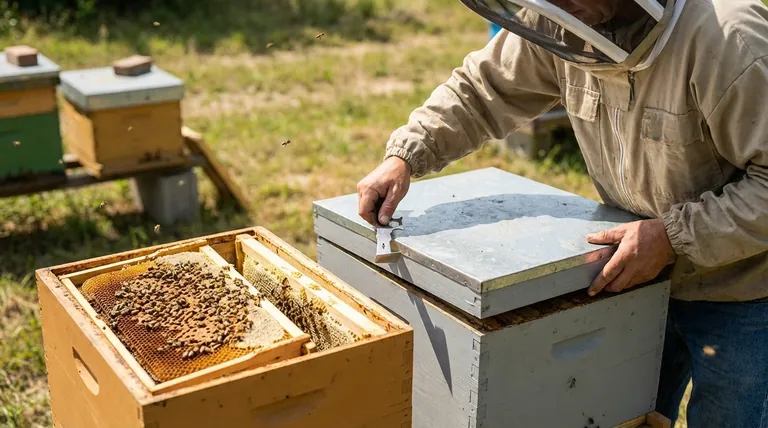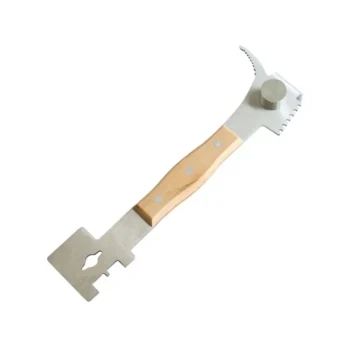It is a common and often frustrating scenario for beekeepers: one hive is booming with activity, while the hive right next to it is noticeably weak and dwindling. Your first step is to perform a thorough inspection of the struggling hive to diagnose the root cause of its weakness. Only after confirming the hive is free of contagious disease should you consider equalizing the colonies by transferring resources like frames of brood or food from the strong hive to the weak one.
The core principle is to act as a diagnostician before you act as a benefactor. Moving resources into a weak hive without understanding why it is weak risks spreading disease, dooming the weak hive anyway, and potentially weakening your strong hive in the process.

The First Step: A Thorough Diagnosis of the Weak Hive
Before any intervention, you must determine the underlying cause of the colony's poor performance. Simply adding bees or brood to a hive with a fundamental problem is a temporary fix that will ultimately fail.
Assess the Queen
The queen is the engine of the colony. A failing queen is one of the most common reasons for a hive to struggle.
During your inspection, you must confirm her status. Look for a tight, consolidated brood pattern with eggs, larvae, and capped brood all present. A spotty, scattered brood pattern or a complete lack of eggs are clear signs of a failing or missing queen.
Check for Pests and Disease
A heavy pest load or an underlying disease can quickly cripple a colony, making it unable to grow.
Your primary focus should be on Varroa mites. Perform a mite count using an alcohol wash or a sugar roll. A high mite load is a severe threat and must be treated before you can expect the hive to recover. Also, look for signs of other diseases like chalkbrood or the foulbroods.
Evaluate Colony Resources
A colony needs both a healthy population and adequate food stores to thrive.
Assess the sheer number of bees. A small cluster has difficulty maintaining the proper temperature for brood rearing and cannot field a large enough foraging force. Also, check their food stores. A lack of honey and pollen will halt brood production and can lead to starvation.
The Principle of Equalization: Sharing Resources Safely
If you have ruled out disease and a failing queen (or have a plan to replace her), you can use your strong hive to support the weak one. This is called equalizing.
What to Transfer
The goal is to provide the weak hive with what it critically lacks.
The most powerful resource is a frame of capped brood that is close to emerging. This provides a massive, immediate boost in population without draining the weak hive's resources to raise them. You can also transfer a frame of honey or pollen if the hive is short on food.
The Transfer Process
How you move resources is critical to ensure they are accepted.
To transfer a frame of brood, find one in the strong hive with mostly capped, emerging bees. Gently shake all the adult bees off the frame and back into their original hive. This prevents older, territorial bees from being moved. Place this frame in the center of the weak hive's brood nest.
Understanding the Trade-offs and Critical Risks
Equalizing hives is a powerful tool, but it is not without significant risks that must be managed carefully.
The Primary Risk: Spreading Disease
This is the single most important consideration. Never move frames from a hive if you suspect any disease or have not confirmed its Varroa mite load is low.
Transferring a single frame from a diseased hive can infect your strong colony, creating a much larger problem than you started with. If in doubt, do not share resources.
The Risk of Weakening Your Strong Hive
A strong hive is a valuable asset. Taking too many resources from it can set it back, reducing its honey production and potentially compromising its own health.
As a general rule, a powerful hive can easily spare one frame of brood and one frame of food without a noticeable impact. Avoid taking more unless absolutely necessary.
Making the Right Choice for Your Apiary
Your specific action depends entirely on your diagnosis. Use this framework to guide your decision.
- If the weak hive is queenless but otherwise healthy: Transfer a frame containing fresh eggs from the strong hive to allow them to raise a new emergency queen.
- If the weak hive is healthy but small and queenright: Boost it with a single frame of capped brood from the strong hive to rapidly increase its population.
- If the weak hive shows signs of disease or a high mite load: Do not transfer anything. Treat the underlying problem immediately and keep the hives completely isolated.
- If a hive is hopelessly weak (e.g., a tiny cluster with a failing queen): Consider cutting your losses by combining the weak colony with the strong one using the newspaper method to save the remaining bees.
By acting as a diagnostician first and a benefactor second, you ensure the health of your entire apiary.
Summary Table:
| Situation | Diagnosis | Recommended Action |
|---|---|---|
| Queenless but healthy | No queen, spotty brood pattern | Transfer a frame of fresh eggs from the strong hive to raise a new queen |
| Healthy but small population | Low bee count, adequate food | Boost with a frame of capped brood from the strong hive |
| Signs of disease or high mite load | Visible pests, poor brood health | Isolate hives, treat the problem—do not transfer resources |
| Hopelessly weak | Tiny cluster, failing queen | Combine with the strong hive using the newspaper method |
Ensure the health and productivity of your entire apiary with the right equipment and supplies. At HONESTBEE, we supply commercial apiaries and beekeeping equipment distributors with high-quality, wholesale-focused beekeeping supplies—from hive tools to mite treatments. Let us help you maintain strong, thriving colonies. Contact our expert team today to discuss your wholesale needs and optimize your beekeeping operations.
Visual Guide

Related Products
- HONESTBEE Advanced Ergonomic Stainless Steel Hive Tool for Beekeeping
- Professional Engraved Round Hive Number Tags for Beekeeping
- Professional Dual-End Stainless Steel Hive Tool for Beekeeping
- Multi-Function Hive Tool with Integrated Hammer for Beekeeping
- Heavy-Duty Stainless Steel Clip-On Frame Perch
People Also Ask
- What are the basic tools for beekeeping? Essential Starter Kit for Safe & Successful Hive Management
- What is the hole in a hive tool for? A Multi-Tool for Apiary Repairs and Maintenance
- Why do hive tools have a hole? Unlock the Secret to Efficient Beekeeping
- How should beekeepers handle bees when using a hive tool? Master Calm, Deliberate Techniques
- Why is it important to compare the progress of different hives? A Beekeeper's Key Diagnostic Tool



















